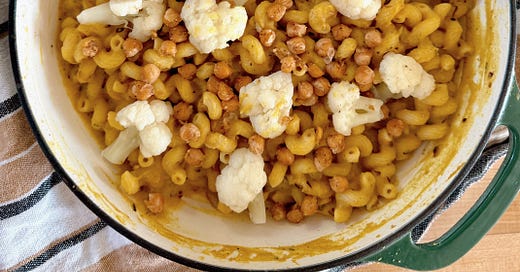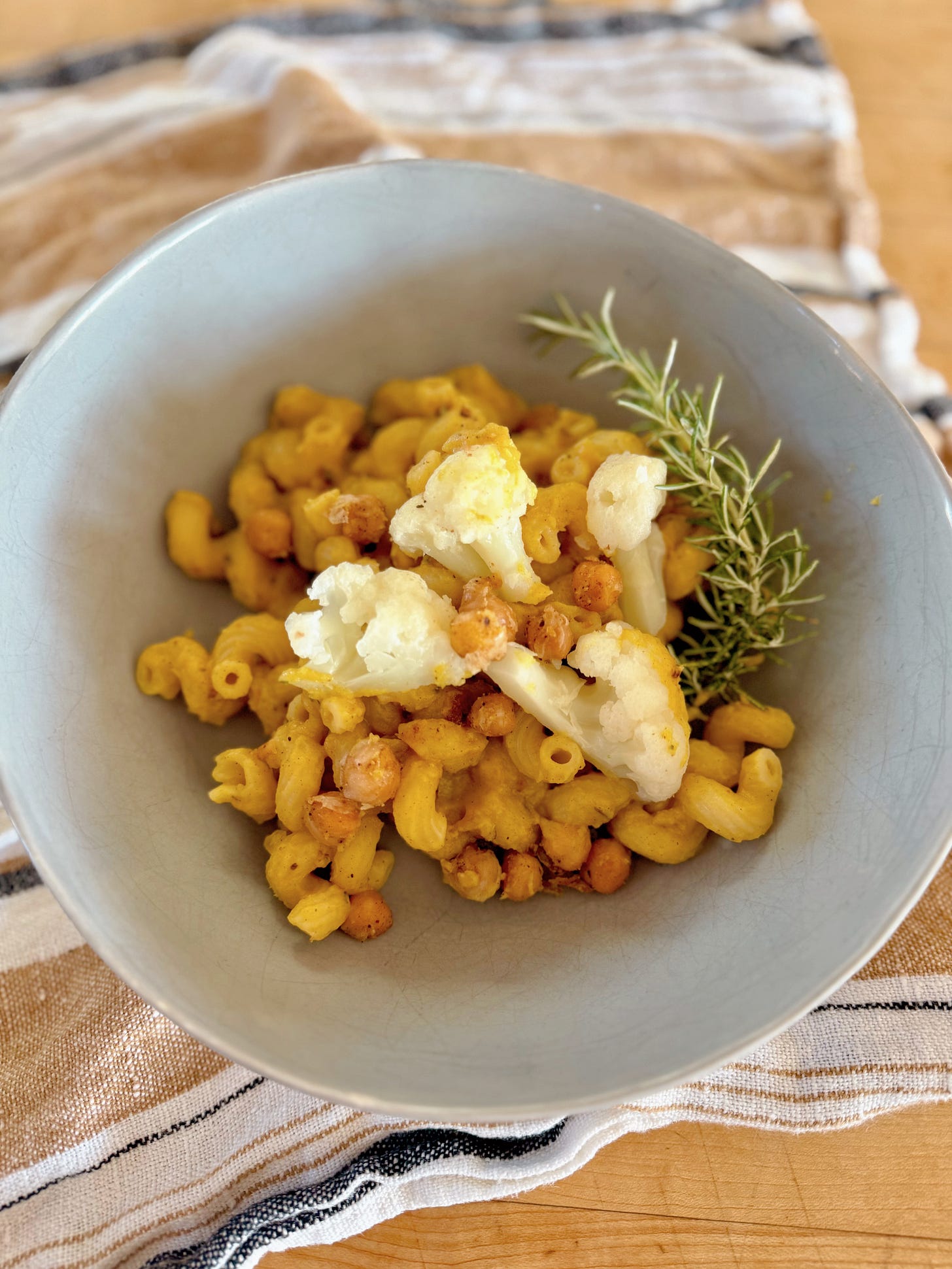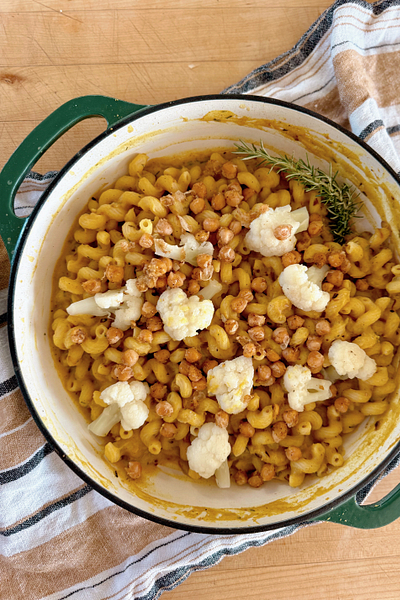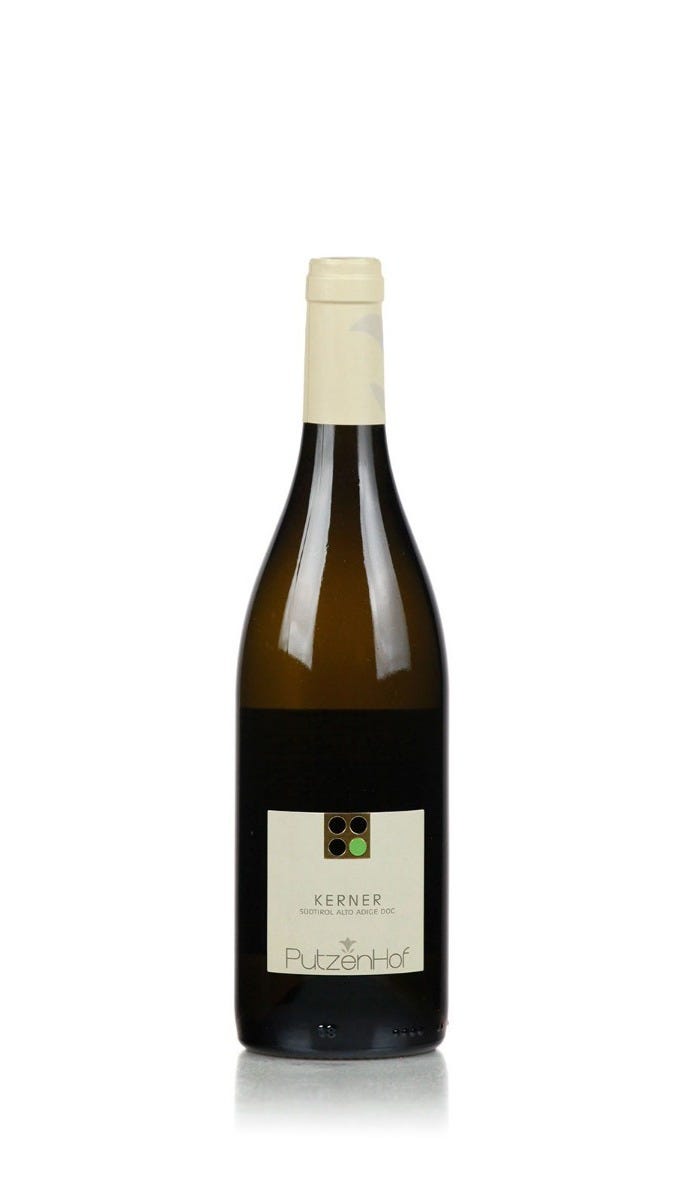Golden is the Color of Health
Creamy “Golden Milk” Chickpea and Cauliflower Pasta + Kerner, the Golden Child of Alto Adige
Some kind of nasty digestive bug is floating around these parts knocking down whole families like dominoes. Two weeks ago, it was our turn. A corned beef was left to soak in a water bath for days, forlorn. A tuna steak went from the freshness of sashimi grade, to in need of an extended olive oil poach. An entire week of menu planning went out the window in favor of whatever would sooth bellies and bodies in the most efficient way. Thankfully, this being California, from sage aura cleansings and colonics to sprouted lentils and B12 injections, I didn’t have to look far for healthful inspiration.
There is a kind of salubrious vibe around these parts that I take for granted. I barely bat an eye anymore when I see coffee menus with mushroom infusions and grass-fed butter or teas boosted with ashwagandha and maca. Generally, I stick to my matcha latte, but occasionally, when I need to dial back the caffeine or feel in need of an immune boost, a turmeric “Golden Milk” latte calls.
That I’ve seen Golden Milk lattes far outside of California’s health food nexus is a testament to the power of turmeric, the spice whose vibrant yellow-orange color gives the drink its name. A native to South Asia, turmeric, whether consumed in its whole, root form or dried and powdered, has long been used in eastern medicine, especially Indian Ayurveda. Unlike many of its coffee menu companions, there is actually some good scientific evidence that turmeric has positive benefits for the body especially in the areas of reducing inflammation and digestive issues. What’s more, adding a very small amount of ground black pepper to turmeric increases the body’s ability to absorb and utilize turmeric by 2000%.
Turmeric and black pepper sounds like the basis for some good cooking.
Given turmeric’s south Asian origins, it is not surprising that one sees the ingredient most commonly in curries, but with a sensitive stomach this past week, I wasn’t in the mood for anything spicy. Fortunately, while trying to work more legumes and veggies into our life recently, I had been experimenting with a dairy-free creamy pasta sauce made with blended cauliflower and chickpeas. Tasty and luscious but somewhat bland in color, turmeric seemed like just the thing to enhance the flavor and pump up the nutrition while lending the whole dish a vibrant hue. Looking to pump up the umami, I slipped in a spoonful of miso paste, then topped the whole dish with a scattering of crispy chickpeas. My earliest iterations were lapped up by our 4-year-old who then asked for more, signalling that even for the bean or veggie averse, this should be a crowd pleaser.
When I was ready consume more than white rice and could stand for 30 minutes at the stove, this was the dish I reached for. Creamy and comforting, light and genuinely wholesome, it is the kind of dish that makes you feel good, in sickness and hopefully, mostly, in health.
Creamy “Golden Milk” Cauliflower and Chickpea Pasta
The pasta cooks in the same water as the cauliflower cutting down on pots, while crisped chickpeas at some texture, all with a glorious golden hue. Did I mention it’s vegan? If you don’t have miso and don’t mind some dairy, omit the miso and stir in two tablespoons of cream at the end.
Serves: 4
Time: 30 minutes
12 oz. cauliflower florets (approximately ½ of a large head)
1 - 15 oz. can chickpeas
2 T. + 4 T. olive oil
¼ tsp. ground coriander
½ lb. pasta such as cavatappi, penne, or any that takes well to creamy sauces
¼ large onion, minced (1/2 cup)
1 T. minced rosemary
2 garlic cloves, sliced
1 T. white miso paste
¼ tsp. turmeric
Pepper
Cut cauliflower into roughly equal sized florets while bringing a medium pot of water to a boil. Salt water. Drain chickpeas and rinse under cold water. Place half of the chickpeas into a blender and set aside. Reserve the other half of the chickpeas.
Add cauliflower to boiling water. Reduce heat to medium and simmer for 6-7 minutes until crisp tender. Remove half of the cauliflower to a bowl with a slotted spoon and set aside. Continue cooking the other half of the cauliflower in the water for another 2-3 minutes until very soft but not falling apart. Remove the remaining cauliflower from the water with a slotted spoon and transfer to the blender with the chickpeas.
Add more water if necessary and bring heat back to a boil. Add pasta and cook according to directions.
While cauliflower is simmering, heat 2 T. olive oil in a large sauté pan over medium-high heat. Add reserved chickpeas and cook for 3- 4 minutes stirring frequently, until chickpeas start to pop. Stir in coriander and cook for another 1 -2 minutes until fragrant and crisped. Remove from the pan and set aside.
Wipe out pan and return to stove over medium heat with remaining 4 T. olive oil. Add onion, rosemary and garlic, cooking for 3-4 minutes until softened.
At the same time, transfer 1 c. of the pasta cooking water and miso paste to the blender with the chickpeas and cauliflower. Blend until a smooth, creamy consistency.
Add turmeric to the pan with the onions, stirring until well combined. Add chickpea-cauliflower sauce to the pan. Taste, adding more salt if necessary (careful as the miso is already salty) plus a healthy dose of black pepper.
When pasta is al dente, transfer directly from the pasta water in the sauce. Stir to combine, adding more pasta water if too dry. Serve topped with reserved cooked florets and crispy chickpeas.
Looking for other recipes that will leave you with that California, wholesome vibe? A few suggestions from the archives…
Chicken Breasts with Farro and Delicata Squash
Roasted Black Cod with Olive Relish
To Drink…
Putzenhof Kerner Alto Adige Sudtirol, Italy 2023
I am the sort of person who dreams of food and wine even while I can touch either. Thankfully I had plenty of wines to dream about following a fun blind tasting with a friend a recently, including this lovely floral Kerner from the Alto Adige that made me feel like I was tramping through a field of mountain wildflowers in springtime.
In wine years, the Kerner grape is a relative baby. Introduced about one hundred years ago as a cross between Riesling and Schiava Grossa, Kerner was the brainchild of a German doctor Justinius Kerner. Still most widely planted in Germany where it is the 5th most popular white grape varietal, I first came across Kerner while hiking in the Dolomites, the famed mountain range that sits in the Alto Adige. Here the grape produces a fragrant, food friendly wine with pleasant, balanced acidity.
In the United Sates, this is still not very common, but I recently tripped across a bottle of Putzenhof Kerner 2023 at Sonoma’s Best Mercantile. The same is sold online through Bottle Barn. Wine.com offers two Kerner options to ship in California but your best bet is to ask your local wine shop, especially if they have a penchant for Northern Italian white wines or German varietals.
According to the grape varietal compendium Wine Grapes, Dr. Justinius Kerner used to “recommend that his patients drink a glass of wine a day as the best natural medicine.” Now that is a health tip that I can get behind.
Putzenhoff from $23.99 at Bottle Barn
Finally, thanks to all who joined our first Meet the Winemaker Virtual Tasting! Laura and Rob Schermeister of Schermeister Wines entertained us all with their passionate love of wine and impressive partnership in life and business. The recording of the session will be on the website available to all paid subscribers who want to dip back in for some lessons on Viognier, making wine with natural yeast, or the highs and lows of being a small, independent winemaker. Stay tuned for our next tasting event in a few months. Hope to see you there!









